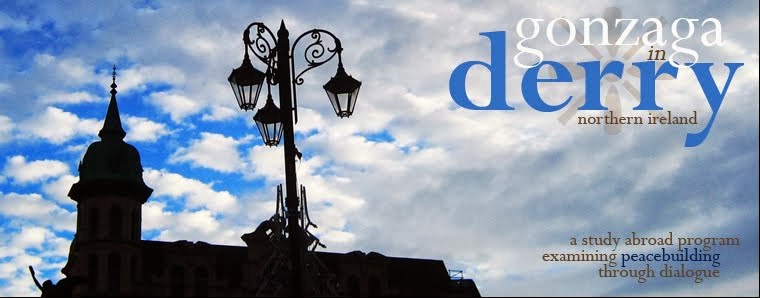
By: Sarah Sinese
Within Derry, the people are working towards peace but there is still a visible, residual dichotomy seen through symbolism in local establishments and the way people address their city. When speaking with representatives from The Junction, the peacebuilding model presented described three main steps: 1) Mere coexistence 2) Mutual dialogue 3) Forgiveness. The community is seen as being somewhere between level 1 and 2. There is still the 3% of people who are resistant to change. However, there are what may seem like small, yet important markers of peace throughout the city.
Although worshipping in different establishments, the members of the two main churches, St. Eugene’s Cathedral (Catholic) and St. Columb’s Church (Protestant) come together each year during the month of Advent along with First Derry Presbyterian Church for an inter-church carol service December 20th on the City Walls at the Bishop Street Gate. It is an opportunity for the communities to come together in building friendship and mutual understanding.
The Apprentice Boys of Derry, a Protestant fraternal society founded in 1814, hold office at Memorial Hall along Society Street where there is now a visitor center. Although they still do not allow Catholics membership within the society, they have now opened the Hall to visitors from all religious backgrounds. Still, there is a wall separating the Bogside and the Hall for protection, a reminder that tensions remain between the two communities.
Perhaps one of the most iconic regions in the city is Bogside, where one will find the murals depicting the sectarian violence during The Troubles. There are three main peace murals, “The Death of Innocence,” “Peace Mural,” and “A Tribute to John Hume.” The art is essentially a story of remembrance, acknowledging the price paid by the victims of the struggle for democratic rights. The Peace Mural (shown below, right) was co-constructed by both Protestant and Catholic children. The overlapping wings of the dove create an oak leaf commemorating the city’s original name and the background of multi-colored squares represents equality. Annette McGavigan (shown below, left) was the 100th victim of a cross-fire between the IRA and British Army in 1971. Changes in the mural including the break in an originally intact gun and the coloring of the butterfly represent a transition from violence to peace. The crucifix in the upper right-hand corner is reminiscent of Jesus’ first words on the cross. Luke 23:24: “Father, forgive them for they know not what they do.”
The murals help all citizens, regardless of class, creed, religion, or political stance realize their roles in The Troubles and confront the wounds they have inflicted upon each other in order to move towards healing and forgiveness. Nelson Mandela, depicted in the lower, right quadrant of the tribute mural (shown below, center) provides a powerful message. Nations who do not deal with the past are haunted by it for generations and that we recall our terrible past in order to deal with it, forgiving when necessary, but not forgetting.





No comments:
Post a Comment